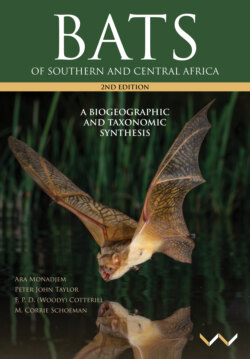Читать книгу Bats of Southern and Central Africa - Ara Monadjem - Страница 42
На сайте Литреса книга снята с продажи.
Forest
ОглавлениеThe northernmost reaches of the region covered in this book interface, in complex, historically derived patterns, with the southern margin of the main belt of moist tropical forests, which extend from the Congo basin into West Africa. This transition zone comprises a forest–savanna mosaic, whose southern limits are represented by the gallery forests that fringe drainage lines in northern Angola, Katanga and northern Zambia (Figures 27, 28, 34). Locally termed mushitu in Zambia or mihulu in Katanga, these gallery forests constitute important habitats for forest-adapted species, including bats. Alongside several species of fruit bats, at least one endemic bat, Rhinolophus sakejiensis, occurs here (Cotterill 2002a, b, 2005, 2006).
Coastal forest mosaic associations extend along the eastern seaboard from Tanzania into the Eastern Cape and KwaZulu-Natal in South Africa.
High-altitude Afromontane forest occurs as ‘islands’ in the Eastern Cape and Drakensberg mountains, the Chimanimani-Nyanga in Zimbabwe, and Gorongosa in Mozambique, and the highlands of Malawi. Relatively few endemic mammals are associated with these forests in southern Africa: a recently described crocidurine shrew (Taylor et al. 2013d) and a golden mole (Carpitalpa arendsi) are endemic to Zimbabwe’s Eastern Highlands.
In addition, riparian forest plays an important role in bat distributions. Riparian fringes along the Limpopo and Zambezi rivers and their major tributaries extend the ranges of several species deep into the semi-arid savanna of southern and northern Zimbabwe. This factor can be invoked to explain outlying records of several species, including Epomophorus dobsonii and Myotis bocagii, and especially Pipistrellus rueppellii. Available data on the diversity of bat communities reveal that bat communities in high tropical forests are richer in species (e.g. at least 59 species in a Liberian study area) (Monadjem et al. 2013b) compared to the richest bat assemblages recorded in the savanna woodlands of southern and Central Africa. In savanna, total species richness ranges from 40 to 45 species at three intensive study sites: Pafuri, Kruger National Park (Aldridge and Rautenbach 1987), Soutpansberg Mountains (Monadjem et al. 2018b) and Sengwa Wildlife Research Area, Zimbabwe (Fenton 1975, 1985). These differences represent the greater diversity of clutter foragers and also frugivorous species in rainforests (Monadjem et al. 2018b).
